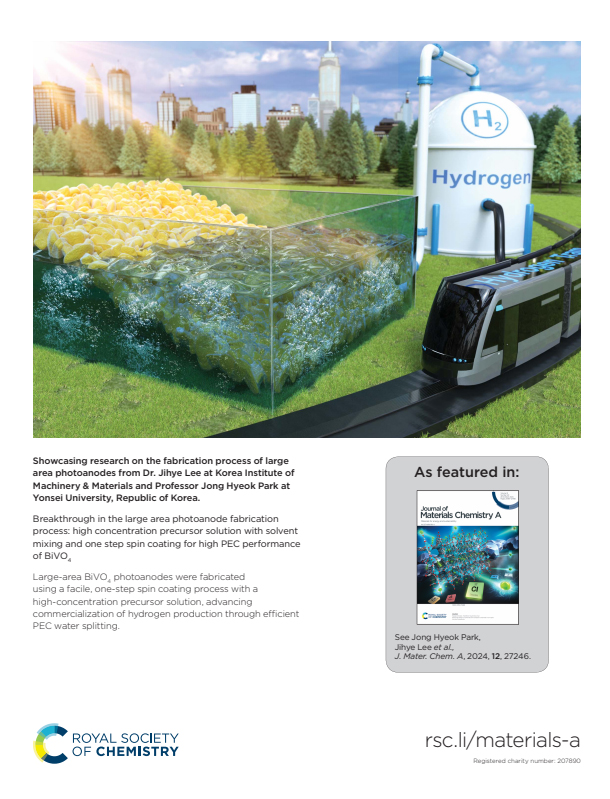
- Created2025.05.22
Opening the Door to Mass Production of Green Hydrogen Using Natural Sunlight!
- KIMM successfully demonstrates a 576 cm² ultra-large photoelectrode system -
- Simplified process and enhanced efficiency through high-concentration BiVO₄ precursor solution technology -
□ The Korea Institute of Machinery and Materials (President Seog-Hyeon Ryu, hereinafter referred to as KIMM), under the National Research Council of Science & Technology (Chairperson Kim, Yeung-Shik), has developed a technology that stably generates high photocurrent under natural sunlight to efficiently produce hydrogen. By simplifying previously complex multi-step processes, this advancement drastically reduces fabrication time and is expected to accelerate the commercialization of solar-powered hydrogen production technologies.
□ The research team led by Dr. Jihye Lee, a principal researcher, head of the Nano-lithography & Manufacturing Research Center at KIMM’s Nano-convergence Manufacturing Research Division, has developed a technique to enhance the productivity of BiVO₄ (bismuth vanadate) photoelectrodes, thereby maximizing hydrogen production. BiVO₄ is a metal oxide recognized as a key material for solar water-splitting systems due to its high light absorption and solar-to-hydrogen (STH) conversion efficiency.
[The research team led by Dr. Jihye Lee, Director of the Nano Lithography Research Center at KIMM]
(From left in the photo: Dr. Jihye Lee, Student Researcher Hoyoung Lee)
□ Previously, BiVO₄ precursor solutions could only be prepared at concentrations up to 100 mM. This limitation necessitated over eight repetitions of spin-coating and heat-treatment steps to form high-performance thin films, which significantly slowed the process and increased material consumption, resulting in low productivity.
□ To overcome these limitations, the research team developed a high-concentration BiVO₄ precursor solution by optimally mixing acetylacetone, acetic acid, and dimethyl sulfoxide (DMSO). With this new solution, a one-step spin coating is sufficient to produce uniform and high-performance BiVO₄ thin films, improving overall productivity by approximately 5.9 times compared to conventional methods.
□ Furthermore, the team fabricated a large-area 144 cm² photoelectrode and connected four of them to create a 576 cm² ultra-large electrode system. Notably, by linking this system in parallel with Si solar cells, they succeeded in producing hydrogen using only natural sunlight, without any external power source. This system generated stable and high photocurrents even under natural sunlight, thus significantly improving the economic viability and efficiency of eco-friendly hydrogen production and enhancing the prospects for commercialization.
[An experiment is being conducted to enhance hydrogen generation efficiency using solar cells under natural sunlight]
□ Dr. Jihye Lee stated, “This research represents a breakthrough in the fabrication efficiency and productivity of large-area photoelectrodes through the development of a high-concentration BiVO₄ precursor solution. We expect it will contribute to accelerating the transition to sustainable energy and the commercialization of green hydrogen production.”
□ The research team has filed for domestic and PCT (Patent Cooperation Treaty) patents based on this technology. The results have also been published in the Journal of Materials Chemistry A (JCR Q1, Impact Factor: 10.7), an international journal issued by the Royal Society of Chemistry.
* Title of the article: “Breakthrough in the large area photoanode fabrication process: high concentration precursor solution with solvent mixing and one step spin coating for high PEC performance of BiVO₄” (https://doi.org/10.1039/D4TA03349C)

[Back cover of the Journal of Materials Chemistry A]
□ This research was supported by KIMM’s Basic Research Program (Development of Core Nanomanufacturing Technologies for Ultra-Realistic Extended Reality Devices), the Ministry of SMEs and Startups (Industry-Academia-Research Platform Cooperation R&D Project), and the Ministry of Trade, Industry and Energy (Electronic Components Industry Technology Development Project and Industrial Technology Alchemist Project).



